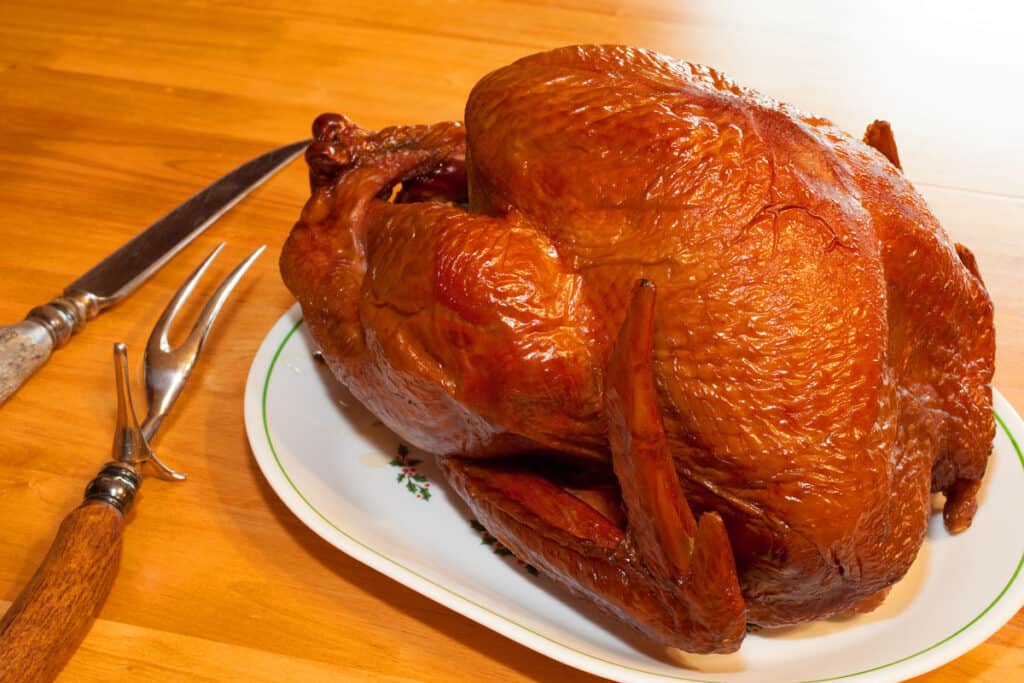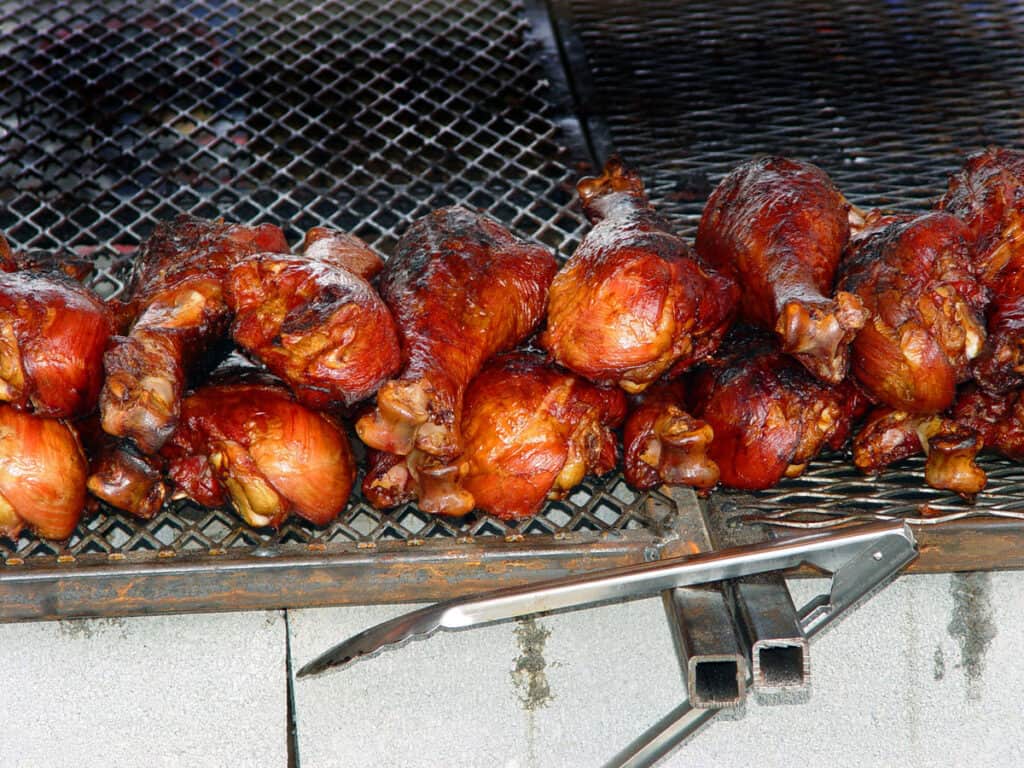Have you heard of the danger zone as it relates to meat products? It affects all types of meat, and turkey is no exception. In this piece, we’ll focus on the turkey danger zone so you’ll know what’s considered a safe temp to smoke turkey.
Turkey Danger Zone
The danger zone for turkey and other meat products is the range between 40 and 140 degrees Fahrenheit. Within this temperature span, bacteria reproduce at a rapid pace. You can help to guarantee food safety by following proper handling and storage practices and cooking the turkey at the right temperature.
What is the Danger Zone?
The “danger zone” refers to the span between the temperatures of 40 and 140 degrees Fahrenheit. It’s the same for all perishable meat products, whether they’re cooked or raw.
When food is stored at temps below 40 degrees, any bacterial growth slows to a reasonable pace. That’s why meat will eventually spoil when kept in the fridge, but it takes longer than if you’d left it on the counter overnight.
At temperatures above 140 degrees, the types of bacteria that cause food-borne illness can’t survive for long. Many meat products are considered fully cooked at 145 degrees, although it’s better to cook poultry for a bit longer.
Keeping meat out of the danger zone is one of the most important factors in food safety. If the meat is allowed to remain in this zone for longer than an hour or two, it can no longer be salvaged.
Some people think that since heat destroys potential bacteria in the first place, you can still cook or reheat meat that’s been sitting out for too long. This won’t work.
While the bacteria might be killed off, the toxins that they created will still be present in the meat. That’s why you should always discard meat that’s been left out at room temperature for too long.
How To Store Turkey
If you’ve purchased a fresh turkey for the smoker, it needs to be stored at temperatures between 26 and 38 degrees Fahrenheit. If it gets any colder, it might start to freeze in patches, but if it gets warmer, you’re approaching the danger zone.
Frozen turkeys should be stored at or below 0 degrees Fahrenheit. The freezer will halt the growth of bacteria indefinitely, but the turkey will maintain a more desirable texture if you thaw and cook it within 12 months.
Can You Smoke Turkey?
Although you should be extra careful when handling raw poultry, there’s no reason why you can’t smoke a turkey instead of roasting it.
It might be a good idea to start with turkey parts before graduating to a whole turkey. These will cook through more quickly, thereby escaping the danger zone without any issues. Turkey breasts, drumsticks, and wings all taste great when smoked.

Smoking whole turkeys is also acceptable, as long as you maintain a safe temperature for the smoker (see section below). We recommend buying the smallest bird you can find if you plan on smoking it. Try to keep the total weight below 12 pounds.
Finally, don’t stuff a turkey before putting it on the smoker. The meat will be cooked at a low temperature—perhaps too low for the stuffing to cook thoroughly. Both the turkey and the stuffing need to heat to 165 degrees in order to be safe to eat.
Furthermore, the smoking process will the stuffing an odd flavor. If you want to serve stuffing with the bird, prepare it on the side and heat it in the oven before serving.
What’s Considered a Safe Temp to Smoke Turkey?
Since you want the turkey to clear the danger zone as soon as possible, aim for a smoker temperature well above 200 degrees. That’s the best way to ensure food safety, especially if the bird is on the larger side.
If your smoker is able to maintain a consistent temperature, set it to 225 degrees. This will allow the meat to cook slowly but thoroughly, imbuing it with plenty of smoky goodness.
Smokers that have a harder time maintaining the set temp should be set a little bit higher, at around 250 degrees. When the smoker temp is in the 225- to 250-degree range, the turkey should cook at a rate of 30 to 45 minutes per pound.
At higher temperatures, the bird will cook more quickly, but it won’t have as much time to absorb the smoke flavor. If you set the smoker to 275 degrees, plan on 20 to 30 minutes per pound.
A 325-degree smoker will cook the bird at an even faster pace—around 15 to 20 minutes per pound. The meat won’t taste quite as smoky, but it should still remain nice and juicy. At this temp, a 12-pound turkey might be on the table in less than 4 hours.
Can You Smoke a Frozen Turkey?
While it’s considered safe to cook meat from a frozen state, this might pose a problem if you want to use the smoker.
It takes about 50 percent as long to cook a frozen turkey as it would to cook a fully thawed one. That means if you assume a 9-hour cooking time for a 12-pound turkey smoked at 225 degrees, cooking it from frozen would take more than 13 hours.
Even if timing wasn’t an issue, the meat would be thawing as it cooked. Therefore, portions of it could be fully cooked while others hovered in the danger zone for hours on end.
To reduce these risks, increase the smoker temperature to at least 325 if you want to smoke the turkey from its frozen state. Or better yet, thaw the bird in the refrigerator for a few days beforehand.
Best Woods For Smoking Turkey
One of the best things about smoking a turkey is that the meat doesn’t require a great deal of seasoning. It has a mild taste on its own, so an intense spice rub might overwhelm the smoke flavor you’re trying to create.
Instead, focus on the type of wood you use in the smoker. Apple is one of the mildest woods you can use and provides a sweet complement to the savory meat. Maple is even sweeter, but its flavor profile can be cloying.
For a stronger flavor boost, try oak wood chips or pellets. It has a hearty taste that’s not too intense for turkey. Beginners should steer clear of hickory and mesquite, as these are too overpowering and might make the meat taste bitter.
Safe Internal Temperature For Smoked Turkey
Remember that the timing guidelines we’ve provided above are just that—guidelines, not hard and fast rules. We’ve found them to be good estimates, but the overall cooking time depends on the individual bird.
Turkey breast is considered done when it reaches an internal temperature of 165 degrees. You can pull it from the heat at 160, as residual cooking will allow it to reach the right temperature while the bird rests.
Dark meat is more succulent when it’s allowed to cook a bit longer. The thighs, drumsticks, and wing meat should attain an internal temp of 180 before you attempt to serve them.
Use a calibrated instant-read thermometer to make sure the turkey is fully cooked. Be careful not to let the thermometer probe touch the bone, as this will provide an inaccurate readout.
Let the turkey rest for 20 to 40 minutes before carving, depending on how big it is. Smaller birds don’t need to rest as long as 18-pound behemoths. Of course, if you’ve followed our advice, your turkey will be on the smaller side anyway.
Tips For Storing Leftovers
Even if you’re smoking your turkey during the colder months, don’t be tempted to store leftovers outside. First of all, it will attract animals who might get to it before you do. Second of all, there’s no guarantee that it will stay cold enough.

If you don’t have room in your fridge to store leftovers, try storing them in a well-sealed container inside a cooler filled with ice. Reheat and eat the turkey as soon as possible, replenishing the ice in the cooler if necessary.
When stored at temperatures below 40 degrees, leftover smoked turkey can keep for up to 4 days. Remember never to leave the leftovers sitting out at room temperature.
Freeze any unused leftovers within that same 4-day period. For optimum flavor and texture, thaw and reheat the turkey within 3 to 4 months, especially if the meat was carved into thin slices.
Final Thoughts
As long as you follow the proper storage practices and your smoker maintains a consistent temperature, you shouldn’t need to worry about the danger zone. The only time it might pose an issue is if the turkey was still frozen when you started cooking.
Happy grilling!

